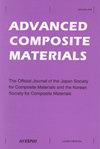新型玻璃纤维增强热塑性复合材料的疲劳行为及自热机理
IF 2.3
3区 材料科学
Q3 MATERIALS SCIENCE, COMPOSITES
引用次数: 0
摘要
本文章由计算机程序翻译,如有差异,请以英文原文为准。
Fatigue behavior and self-heating mechanism of novel glass fiber reinforced thermoplastic composite
In this study, fatigue properties of a novel continuous glass fiber reinforced composite with an acrylic-based thermoplastic matrix Elium®, have been investigated and S-N curves were obtained. The effect of various fiber orientations of the plies with glass fibers of 0°/90°/±45°, 0°/90°, and ±45° alignment has been evaluated. The highest fatigue strengths have been recorded for composites with 0°/90° glass fiber ply orientations. Composite with ±45° alignment has the lowest fatigue strengths in S-N curves. Stiffness degradation of the composites with 0°/90° and 0°/90°/±45° at medium fatigue stress levels was calculated and showed higher degradation for stacking having more off-axis plies, i.e. 0°/90°/±45° alignment. Temperature increase during fatigue testing was measured using an IR camera for a medium fatigue stress level for 0°/90°/±45° alignment. Temperature increases were calculated for all stress amplitudes for composites with 0°/90°/±45° and 0°/90° alignment cross-ply sequences. The temperatures obtained were all below the glass transition temperature of the material. The 0°/90°/±45° plies had a higher temperature effect than 0°/90° plies in both analytical calculations and observations.
求助全文
通过发布文献求助,成功后即可免费获取论文全文。
去求助
来源期刊

Advanced Composite Materials
工程技术-材料科学:复合
CiteScore
5.00
自引率
20.70%
发文量
54
审稿时长
3 months
期刊介绍:
"Advanced Composite Materials (ACM), a bi-monthly publication of the Japan Society for Composite Materials and the Korean Society for Composite Materials, provides an international forum for researchers, manufacturers and designers who are working in the field of composite materials and their structures. Issues contain articles on all aspects of current scientific and technological progress in this interdisciplinary field. The topics of interest are physical, chemical, mechanical and other properties of advanced composites as well as their constituent materials; experimental and theoretical studies relating microscopic to macroscopic behavior; testing and evaluation with emphasis on environmental effects and reliability; novel techniques of fabricating various types of composites and of forming structural components utilizing these materials; design and analysis for specific applications.
Advanced Composite Materials publishes refereed original research papers, review papers, technical papers and short notes as well as some translated papers originally published in the Journal of the Japan Society for Composite Materials. Issues also contain news items such as information on new materials and their processing."
 求助内容:
求助内容: 应助结果提醒方式:
应助结果提醒方式:


